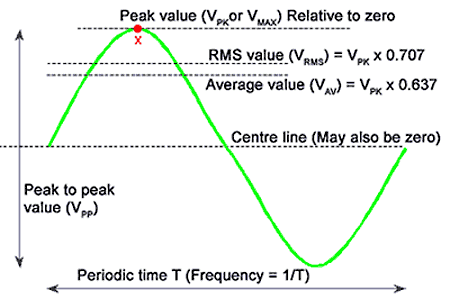An a.c. circuit is one in which the magnitude of the current changes periodically with time. The a.c. is produced by an alternating voltage supply. The pattern of the a.c. voltage is sinusoidal in nature, that is it varies like the sine curve with constant amplitude and frequency.

V0 is the maximum or peak voltage, which represent the maximum displacement (amplitude).
V is the instantaneous voltage, representing the displacement.
Now, sinθ=VV0
Hence, V=V0sinθ=V0sinωt
The rms voltage is defined as the steady voltage which would produce the same heating effect per second in a given resistor.
The rms value of current is defined as the steady current which would dissipate at the same rate in a given resistor.
V0=2Vrms−−−−−√∴V=2Vrmssinωt−−−−−−−−−√
Thus, V=2(Vrmssin2πft)−−−−−−−−−−−−√
Where ω = 2πf
Similarly,
I=I0sinθ=2(Irmssinωt)−−−−−−−−−−√I=2(Irmssin2πft)−−−−−−−−−−−−√I0=Irms2–√
Where:
V : Instantaneous value
V0: Peak value
Vrms : root mean square value.
Also,
I: Instantaneous value
I0 : peak value
Irms : root mean square value.
θ: phase angle between voltage and current
ω: angular velocity
The ability of a resistor to restrict the flow of current in an a.c circuit is called its resistance R.
When an a.c is applied to a resistor, both current and the voltage attain maximum and minimum at the same time. Hence, they are in phase.
According to Ohm’s law,
R=VII0=V0RIrms=VrmsR
EVALUATION (POST YOUR ANSWERS USING THE QUESTION BOX BELOW FOR EVALUATION AND DISCUSSION):
Read our disclaimer.
AD: Take Free online baptism course: Preachi.com 